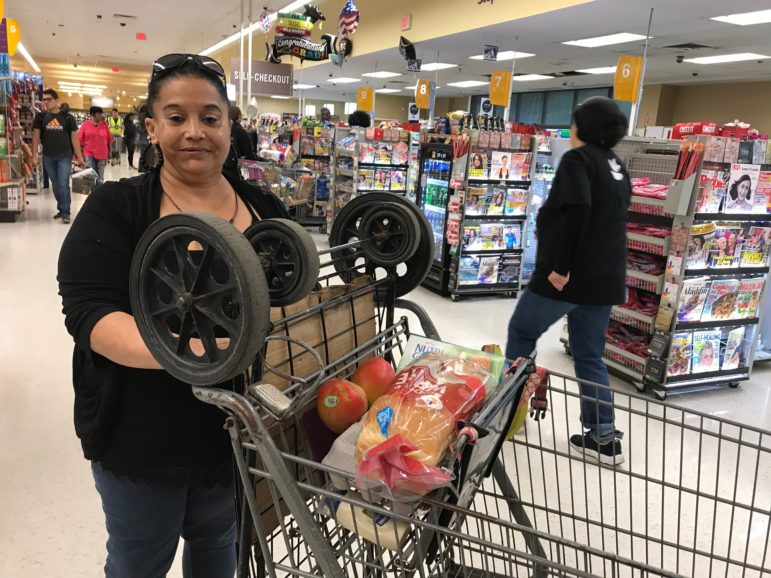By Colleen Shaddox
Wanda Perez considers the price and nutritional value of everything she puts in her shopping cart, as the New Haven woman relies on the Supplemental Nutrition Assistance Program (SNAP) to buy groceries and is trying to eat healthy to manage multiple chronic illnesses.
Just over 364,000 people receive SNAP benefits in the state, a number that has decreased about 4.7% in the past year.
“I try to stay on top of everything that’s going on,” said Perez, a member of Witness to Hunger, which organizes SNAP users to speak about food policy and poverty. Perez lives on just over $700 in disability assistance a month, plus $192 in SNAP.
Though her SNAP benefits are safe for now, proposed federal rule
changes could push other Connecticut users off SNAP. The federal
government is proposing to limit access for unemployed residents and for
people close to the current federal poverty level.
C-HIT’s Colleen Shaddox spends time at the grocery store with Wanda Perez, a SNAP recipient who shops for food bargains.
Unemployed Able-Bodied Adults Without Dependents (ABAWDs) may only receive three months of benefits over a three-year period, but today in most of Connecticut they can receive waivers to extend SNAP longer based on unemployment rates. Under a proposed federal rule change, most of those waivers would end. Currently residents in 108 of Connecticut’s 169 towns qualify for the waiver.
“People are stuck, and it sometimes takes a very long time for people to get their feet back on the ground, and while they are doing that, they don’t need to be punished by not having enough food to eat,” said. Bernard J. Beaudreau, CEO of Connecticut Food Bank. He cited low-wage jobs, a gig economy and the difficulty older workers face in getting retrained for available jobs.
Gov. Ned Lamont, in a letter to the U.S. Department of Agriculture (USDA), said, “These waivers allow states to protect individuals in areas where finding a job can be difficult, by continuing to provide basic food support while they look for employment.” Lamont urged the USDA to increase funding for job training within SNAP. According to the governor, 70% of SNAP recipients who participate in training through the program find employment.
About a quarter of the people receiving SNAP have a disability that limits their ability to work, according to the Center for Budget and Policy Priorities, but not all of them meet the federal standard for disability – something that is getting harder to do.

Colleen Shaddox Photo.
Wanda Perez is a SNAP recipient who advocates for others in the program.
John Spilka, an attorney with Connecticut Legal Services, helps people qualify for federal disability programs, a process that he said can take years and offers poor prospects of success. “If you look back 20 years ago, we were probably winning 80 to 90% of our cases,” he said. “Today it’s much less.”
While applicants with resources may be able to visit specialists, who can document a medical case, Spilka represents underserved people. “My clients can’t pay for reports,” he said.
A second proposed federal rule change would also affect SNAP eligibility. To qualify for SNAP, a household’s income cannot exceed 130% of the federal poverty level (FPL). For a family of three, that would be $2,252 a month. But the federal Office of Management and Budget proposed last month to change the way it calculates the federal poverty level that would effectively lower it and disqualify more people for benefits that are tied to the measure, including SNAP, Head Start and school lunches.
“You’re making a choice that is going to weaken all our basic assistance programs,” said Sherry Suber, SNAP program manager at End Hunger CT.
Suber and Beaudreau both said that the nonprofit food assistance system is already too small to meet that need. “Our resources haven’t grown,” said Beaudreau. “We’ve had very flat revenues in terms of donor support.”
Food insecurity is particularly acute in the summer, when children do not have access to school breakfast and lunch. The average child will miss 100 school meals over the summer break, said Beaudreau. Food programs around the state try to fill the gap, but access can be difficult in some areas, he said.
For Perez, summer is actually a better time for her food budget. She gets tomatoes and vegetables from her father’s garden. On a low-fat diet, she often looks for specials on fruits and yogurt. She walks past the fresh fish counter because “it’s too expensive.”
At 52, she’s already had a stroke. Her mother died of heart disease at 54, and Perez is working hard on eating well. “I want to be around to see my grandchildren become adults,” she said.
She expects to be talking with her members of Congress about the proposed federal changes soon. “Everybody got a voice,” she said.
Support Our Work
The Conn. Health I-Team is dedicated to producing original, responsible, in-depth journalism on key issues of health and safety that affect our readers, and helping them make informed health care choices. As a nonprofit, we rely on donations to help fund our work.Donate Now

